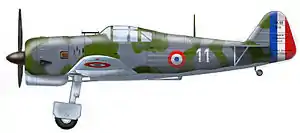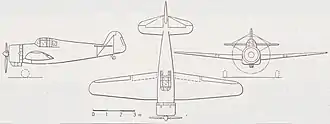Koolhoven F.K.58
The Koolhoven F.K.58 was a single engine, interceptor-fighter aircraft designed and mainly manufactured by N V Koolhoven in the Netherlands under contract by France. Intended for Armée de l'Air use, the F.K.58 saw limited service in the Battle of France.
| F.K.58 | |
|---|---|
 | |
| Koolhoven FK.58 anti-aircraft defense patrol D.A.T. (Polish) at Clermont-Aulnat, June 1940 | |
| Role | Fighter |
| Manufacturer | Koolhoven |
| Designer | Erich Schatzki |
| First flight | 17 July 1938 |
| Introduction | 1940 |
| Retired | 1940 |
| Primary users | French Air Force Polish Air Force |
| Produced | 1939-1940 |
| Number built | 20 |
Design and development

In 1937, the French Conseil Supérieur de l'Air decided that domestic aircraft manufacturing capacity could not, in the event of war, equip the Armée de l'Air with fighters quickly enough. The Dutch manufacturer Koolhoven was contracted to design a cheap, easily built, high-performance fighter, that could be built and serviced with French-supplied engines and other components. According to some sources, the Koolhoven fighter was intended primarily for fighter units based in French colonies.
The prototype Koolhoven Model 1166, designed by Erich Schatzki, flew for the first time on 17 July 1938. The structure of the fuselage consisted of welded steel tubing covered with sheet metal (front part) and fabric (aft); the wing had 2 wooden box spar members and ribs, with a bakelite stressed skin covering. Aerodynamically balanced split flaps on the wing trailing edges ensure a lower landing speed. The oleo-pneumatic undercarriage retracted inwards with the wheels housed in the lower fuselage faired into the lower engine cowling by small doors. The empennage is built up from wood and control surfaces are metal framed with fabric covering.
In January 1939, the Armée de l'Air placed an order for 50 aircraft, to be powered by Gnome-Rhône 14N engines.
Due to the unavailability of Gnome-Rhône engines and French instruments, just 17 aircraft – six F.K.58s and 11 F.K.58As – were completed at the Koolhoven works, with Dutch supplied engines and instruments – and delivered to the Armée de l'Air. Production was transferred to Nevers, where the aircraft were re-built with French components and the extraneous parts were returned to the Netherlands. However, only one more F.K.58 was produced from scratch at Nevèrs.
In July 1939, the Dutch government placed an order on behalf of the Luchtvaart Afdeling (Netherlands Army Aviation Corps) for 36 F.K.58 variants, powered by Bristol Taurus engines. As the British government restricted exports of the Taurus, they were to be replaced by Dutch stocks of the Bristol Mercury VIII (as used by the Dutch Fokker D.21 and Fokker G.1). The lower output of the Mercury, relative to the Taurus, would have reduced top speed to some 480 km/h (300 mph; 260 kn).
The F.K.58s comprising the Dutch order were in various stages of construction when they were destroyed by a German air raid on the Koolhoven factory in May 1940.[1]
Had the Armée de l'Air received its full order of 50 aircraft, before for the Battle of France, it is unlikely that they would have changed the outcome. The F.K.58s that became operational were regarded as superior to the Morane-Saulnier M.S.406, comparable to the Bloch MB.151,, but inferior to the Dewoitine D.520 and the latest German fighters.
Operational history

The F.K.58 was originally ordered to serve with AdA units based in French overseas territories. Following the outbreak of war with Germany, however, the type was assigned to an ad hoc, Free Polish air force unit commanded by Captain Walerian Jasionowski. Roughly equivalent to a French escadrille, or Polish eskadra,[2] it was often known by the unofficial name "Eskadra Koolhoven". The unit's official role was patrouille ("patrol") – as the AdA designated units that defended rear areas against long-range bombers and other enemy aircraft, as part of the Défense Aérienne du Territoire ("Territorial Air Defense"; DAT). The unit operated from the Salon and Clermont-Aulnat air bases.
By May 1940, 13 aircraft were operational with Eskadra Koolhoven. As delivered, however, the fighters were unarmed and the Poles had to acquire machine guns and fit them. From 30 May 1940, they were in service, patrolling firstly in the Avignon-Marseille area, and then over Clermont-Ferrand. At least 47 operational sorties were recorded, but the Escadron did not encounter enemy aircraft.
The type's service life was short-lived, with ; the unit had no confirmed victories, but at least one F.K.58 was lost. After the fall of France, all surviving airframes were scrapped.
Variants
- F.K.58 Prototype
- Prototype powered by 1,080 hp Hispano-Suiza 14AA engine, 2 built.
- FK-58 [Bristol Taurus]
- Dutch version powered by Bristol Taurus engine, projected Dutch aircraft, none built.
- F.K.58
- First production variant powered by Hispano-Suiza 14AA radial engine, 7 built.
- F.K.58A
- Production version powered by Gnome-Rhône 14N-16 engine, 11 built.
Operators
- Polish Air Forces in exile in France
- Eskadra "Koolhoven" operated eight aircraft, probably all were FK.58A variant.
Specifications (F.K.58)

Data from Flight 6 October 1938 : A 300 m.p.h. KOOLHOVEN FIGHTER,[3] Jane's all the World's Aircraft 1938[4]
General characteristics
- Crew: 1
- Length: 8.69 m (28 ft 6 in)
- Wingspan: 9.96 m (32 ft 8 in)
- Wing area: 17.3 m2 (186 sq ft)
- Empty weight: 1,810 kg (3,990 lb)
- Fuel capacity: 505 l (133 US gal; 111 imp gal) in three wing tanks
- Powerplant: 1 × Hispano-Suiza 14AA-10 14-cylinder air-cooled radial piston engine, 810 kW (1,080 hp) at 4,511 m (14,800 ft)
alternative powerplants include:- 670 kW (900 hp) Bristol Taurus and 770 kW (1,030 hp) Gnome-Rhône 14N-16
- Propellers: 3-bladed variable-pitch propeller
Performance
- Maximum speed: 483 km/h (300 mph, 261 kn) at 4,493 m (14,740 ft)
- Cruise speed: 431 km/h (268 mph, 233 kn)
- Range: 853 km (530 mi, 461 nmi)
- Service ceiling: 10,200 m (33,500 ft)
- Rate of climb: 16.3 m/s (3,210 ft/min) at 4,001 m (13,126 ft)
- Time to altitude: 6,998 m (22,960 ft) in 8 minutes 48 seconds
- Wing loading: 147 kg/m2 (30.2 lb/sq ft)
- Power/mass: 0.31 kW/kg (0.19 hp/lb)
Armament
- Guns: 4 × 7.5 mm FN-Browning machine guns in underwing fairings
See also
Aircraft of comparable role, configuration, and era
- Bloch MB.152
- Curtiss P-36 Hawk
- IAR 80
- Fokker D.XXI
- Hawker Hurricane
- Messerschmitt Bf 109
- Mitsubishi A6M Zero
- Morane-Saulnier M.S.406
Related lists
Notes
- Visschedijk, Johan (31 July 2014). "VAN A. SWINDELLE COLLECTION No. 8142. Koolhoven F.K.58A (PH-AVK c/n 5808)". 1000aircraftphotos.com. Retrieved 12 June 2016.
- In military aviation, the term escadrille, which is sometimes translated into English as squad, originally referred to a unit that was larger than a flight, but smaller than a squadron.
- "A 300 m.p.h. KOOLHOVEN FIGHTER". Flight, the Aircraft Engineer and Airships. XXXIV (1554): 298. 6 October 1938. Retrieved 12 October 2019.
- Grey, C.G.; Bridgman, Leonard, eds. (1938). Jane's all the World's Aircraft 1938. London: Sampson Low, Marston & Co. p. 218c.
Bibliography
- Comas, Mathieu (August 1997). "Un chasseur hollandais pour la France: Le Koolhoven FK 58 (1ère partie)" [A Dutch Fighter for France: The Koolhoven FK 58]. Avions: Toute l'aéronautique et son histoire (in French) (53): 22–29. ISSN 1243-8650.
- Comas, Mathieu (September 1997). "Un chasseur hollandais pour la France: Le Koolhoven FK 58 (2ème partie)". Avions: Toute l'aéronautique et son histoire (in French) (54): 10–17. ISSN 1243-8650.
- Comas, Mathieu (October 1997). "Un chasseur hollandais pour la France: Le Koolhoven FK 58 (3ème partie et fin)". Avions: Toute l'aéronautique et son histoire (in French) (55): 35–41. ISSN 1243-8650.
- Green, William. Warplanes of the Second World War: Fighters. Volume III London: Macdonald & Co.(Publishers), 1961. ISBN 0-356-01447-9.
- Taylor, John W.R. "Koolhoven F.K.58." Combat Aircraft of the World from 1909 to the present. New York: G.P. Putnam's Sons, 1969. ISBN 0-425-03633-2.
External links
| Wikimedia Commons has media related to Koolhoven F.K.58. |